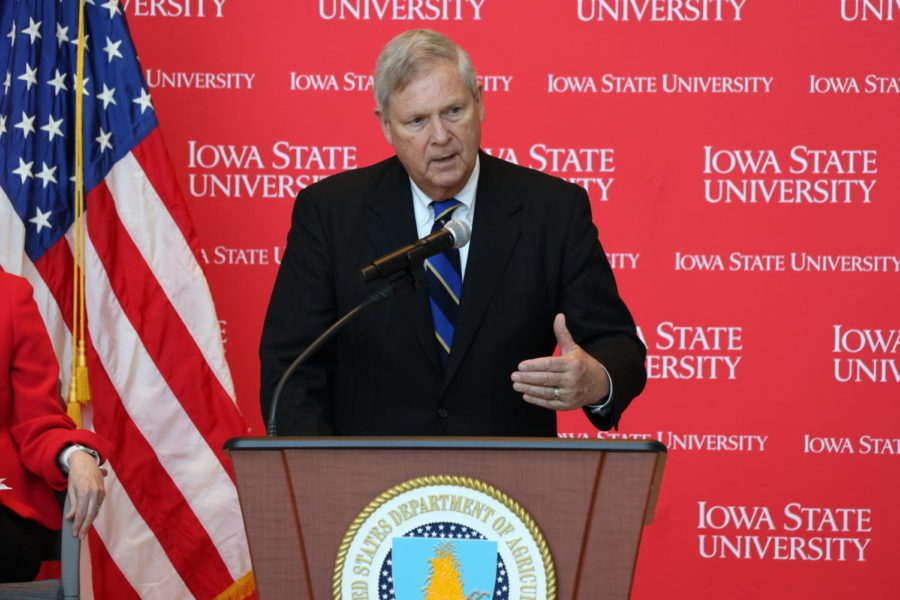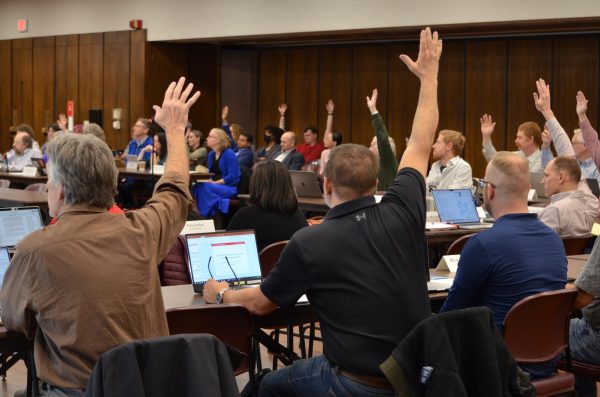- News
- News / Politics And Administration
- News / Politics And Administration / Campus
- News / Politics And Administration / State
- Politics
ISU partners with USDA to focus on conservation and nutrition management
U.S. Agriculture Secretary Thomas Vilsack speaks about conservation innovation on Apr. 6, 2023.
U.S. Secretary of Agriculture and former Iowa Governor Tom Vilsack visited Iowa State Thursday afternoon to discuss projects regarding conservation and nutrition management.
Vilsack said the United States Department of Agriculture (USDA) will invest $40 million throughout the rest of the year to be dispersed among 31 projects funded through Conservation Innovation Grants, which Iowa State University has received through Iowa Learning Farms, a program based at Iowa State which aims to build a culture of conservation, according to their website.
An additional $19 million will also be invested between two projects funded through the Regional Conservation Partnership Program.
Conservation Innovation Grants
“It’s incredibly important for the country that we continue to increase our commitment overall to publicly financed research, and to work collaboratively and closely with land grant universities like Iowa State where there is amazing research being done every single day,” Vilsack said.
Iowa Learning Farms Program Director Jacqueline Comito, a manager of research for the Agricultural and Biosystems Engineering Department, said because the Iowa Nutrient Reduction Strategy does not include relay intercropping as a nutrient reduction practice. She added since there is no water quality performance data, the Iowa Learning Farms team will conduct water quality and soil health research on relay intercropping.
“Despite potential soil health and water quality impacts of relay intercropping systems, there is a clear need to document these potential benefits,” Comito said.
The project Iowa Learning Farms will be researching the effect of relay intercropping on six commercial farms and three university research farms for three growing seasons.
“This demonstration project will take a multifaceted approach to evaluating a relay intercropping system that integrates […] cereal grains, either winter wheat or rye, into corn and soybean production systems,” Comito said. “Despite potential soil health and water quality impacts of relay intercropping systems, there is a clear need to document these potential benefits.”
Mark Licht, an associate professor of agronomy and an Iowa Learning Farms extension collaborator, said relay intercropping may increase land productivity.
“What happens is the productivity of soybeans may be decreased a little bit, but because you’re gonna get a green production out of the winter wheat or the winter dry […] your land equivalent production is going to be greater,” Licht said.
Comito said Iowa Learning Farms plans to make a “great effort” to reach out to historically underserved farms.
“Those would be beginning farmers, those would be veteran farmers, as well as the other cast of characters,” Comito said. “We would also want to reach out to those farmers, as Secretary Vilsack told us earlier, who are on small farms and mid-range farms. And actually, we believe that this practice will appeal to them because it’s going to add some value to their farms and help them increase their income streams.”
Licht said by intensifying the cropping system, farmers may have a larger yield and make more of a profit as opposed to just cover cropping.
“Another way of thinking of it is if soybean production is a productivity level of an eight alone, and then you come in and you do intercropping, you may go down to like a productivity of seven with the soybeans, but then you may have productivity of three with the wheat, so now instead of having a total productivity of eight, you’ll have a total of 10,” Licht said.
Vilsack said researching the project may be difficult for farmers to engage with initially.
“It’s tough to ask farmers to do this, because oftentimes, it requires an expenditure and investment upfront, and it’s important for farmers to be able to see the benefit of that investment before we ask them to essentially spend their own resources,” Vilsack said, “so the on-farm program really provides additional resources to make it a little bit easier for farmers to embrace innovation and conservation.”
Comito echoed sentiments similar to Vilsack, saying that understanding generational identities and tapping into the values of farmers may be key to getting them to adopt new practices.
“The introduction of an innovative conservation practice, such as a third cash crop, is often complicated by farmers’ social identities and the social loss a farmer may experience with doing something new,” Comito said.
“So while the feasibility of relay intercropping soybeans into a small grain depends on factors such as soybean agronomic management […] and improvements in nutrient reductions, adoptions of this practice will also depend on […] whether it is socially accepted by farmers,” Comito said.
In an interview with the Iowa State Daily, Wendy Wintersteen, president of Iowa State University, said the USDA’s partnership with Iowa State will provide students with an opportunity to be part of the project.
“They’ll employ students into research or extension components of the project; the students will see firsthand what it means to be involved in the project, [and] they’ll learn and experience the different aspects of the project,” Wintersteen said. “For some of the students, it’ll mean that they’ll get to work with farmers and see how the farmers consider different aspects of the project– the social aspects of the project. For others, it’ll be perhaps collecting data.”
Wintersteen said for farmers, the project will give them an opportunity to test the new practices on their farm.
“It’s my understanding [that] it gives them the opportunity to see if it’s a practice that would work on their farm– a practice that they would want to build in as a standard practice,” Wintersteen said.
Regional Conservation Partnership Program
Vilsack also announced a $19 million investment in two projects focused on nutrition management. The grants were awarded to Family Farms LLC and the Environmental Initiative, Inc. according to a press release from the USDA.
“We’re expending about $9.8 million with […] the Family Farms LLC, which is going to look at biochar in terms of conserving nutrients along the Mississippi River Basin,” Vilsack said, “and $10 million to the Environmental Initiative, Inc., which is going to essentially take a look at [the] interconnection of farms with multiple mitigation strategies to try to reduce […] runoff.”
Vilsack also announced the signing of two memorandums of understanding (MOU) to further conservation efforts.
“We’ll be signing today a series of MOUs to expand the technical capacity that NRCS [Natural Resources Conservation Service] needs to provide to farmers out of the countryside,” Vilsack said. “One with the American Society of Agronomy, and one with Truterra, which is the land of lakes effort.”
Your donation will support the student journalists of the Iowa State Daily. Your contribution will allow us to purchase equipment, send our student journalists to conferences and off-set their cost of living so they can continue to do best-in-the-nation work at the Iowa State Daily.













